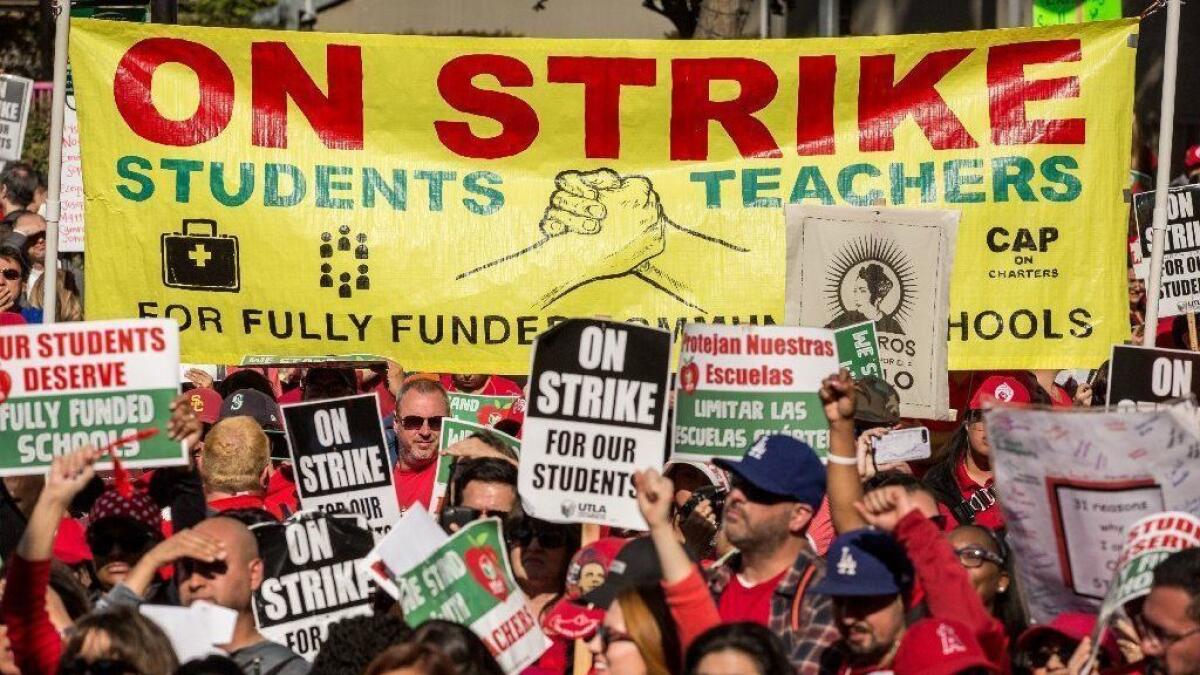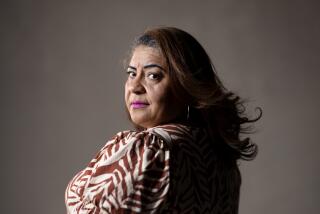The teachers’ strike gripped LA for 6 days. A year later, what are the results?

Arnoldo Vargas’ life hasn’t changed much since last January when he joined thousands of Los Angeles teachers in a momentous six-day strike. He drives the same 2006 Camry, has no more than 41 students in his art classes compared to an average of 42 last year, and would love to see his own eighth-grade son and first-grade daughter in smaller classes.
“A lot of the gains, I don’t see them ... day-to-day, to be honest,” said Vargas, who teaches at Banning High School in Wilmington.
A year after some 30,000 teachers walked out of their classrooms and upended the daily routine of more than half a million students and their families, most parents and teachers would be hard-pressed to see defining differences in classrooms and schools. Most classes are one student smaller, and the district has been unable to hire the nurses promised for every campus.
The strike helped fuel a nationwide wave of activism and drew attention to what many say is a lack of resources supporting public schools. But there remains much debate about how much — or how little — changed inside classrooms.
Whatever the gains, they came at some cost. Students lost six days of instruction and the district lost more than $100 million in state funding, which is based on student attendance. Teachers sacrificed about 3% of their pay when they walked out, and settled for the same 6% the district offered before the strike.
L.A. schools Supt. Austin Beutner declined to answer questions for this story. In previous interviews, he has downplayed what was achieved by the strike, saying the district’s offer on such issues as immediate class-size reduction did not substantially change before and after the walkout. And more substantial reductions, in three to four years, arecontingent on whether the district receives more funding, he has said. He also has said that he’d like one legacy of the strike to be an ongoing partnership with the union to pursue additional money.
Leaders of United Teachers Los Angeles and their allies say their hard-fought gains already are game-changers — within schools and in the political realm that shapes public education policy. They said the strike created an essential beginning toward achieving smaller classes and schools fully staffed with nurses, librarians and counselors.
They count some of their biggest gains in non-traditional areas. For example, the agreement called for the district to commit to expanding social services at more schools and to begin dismantling the practice of randomly searching students for contraband. The union also lays claim to helping pass new state laws that restrict charter schools, which are privately operated and, for the most part, non-union.
But the political influence had limits. Just a few months later, L.A. voters rejected a property tax measure that both union and district leadership had hoped would stabilize district finances and help pay for improvements talked about during the walkout, such as smaller classes.
The UTLA strike was “symbolic, political theater, a way of showing value rather than proving it,” said Will Swaim, president of California Policy Center, an Orange County group that works to persuade workers to leave unions.
Some critics even portray union gains as coming at the expense of students. They fault the union, the school board and Beutner for setting aside an opportunity to reshape an unsustainable status quo when it comes to the district’s long-term financial health. The danger, they say, is that the increasing cost of employee pensions, retiree healthcare and generous employee benefits will crowd out services to students.
“These were not courageous leadership decisions,” said Bill Lucia, executive director of the Sacramento advocacy group EdVoice.
L.A. school board President Richard Vladovic takes issue with the naysayers. He said the district is unlikely to become insolvent and that the strike successfully put a focus on public education.
“It’s tough to be a teacher and it’s tough to be in education,” said Vladovic, whose long career includes participating in a strike as a teacher and dealing with later walkouts as an administrator. “I think there’s now a real sense that people need to listen to what teachers are saying about the classroom. I think that’s a good thing. I will never say a strike is good for anything, but if that’s what it takes to move a system, then so be it.”
And within the union, the strike served as a counter-thrust to inspire and build membership in the wake of a 2018 Supreme Court ruling that said public employees cannot be forced to pay union fees in exchange for representation.
Vargas of Banning High said he remains proud of the strike, believes in union activism and feels strongly about the need for limits on charter schools.
“You do what you can now,” he added, and then you keep fighting.
Class sizes, more hiring
During the strike, teachers forcefully called for much smaller classes to improve achievement, as well as for more school nurses and counselors.
The contract called for a decrease in average class sizes of one student per class in grades four through 12, although some targeted schools received additional reductions. The reductions will continue incrementally in future years: one additional student next year and two the following year.
This year, for instance, class size averages for high school math or English range from about 29 to 35, depending on the course. The maximum number of students is 39. Although the previous contract had maximums, they were not enforced.
Trinity Haywood, a junior at Los Angeles Center for Enriched Studies in Mid-City, said her largest class last year, honors English, had about 44 students. Her largest class this year, chemistry, has 37.
In the fall of 2018, before the strike, more than 200 elementary classes had more than the maximum number of students specified in the previous contract, according to the union. This fall, it fell below 30.
For Trinity, classes with 30-some students still feel difficult for teachers to manage. Some students talk in the back of the room, which can make it hard to pay attention to the lesson, she said.
Trinity also has periodic migraines, which exposes a post-strike shortcoming. Most times, she said, she can’t get medicine or lie down in the nurse’s office, which is often locked without a full-time nurse.
“It’s like, ‘Too bad, here’s an ice pack,’” she said.
The union won a provision that called for a full-time nurse in every school within three years, with an increase of 150 this year. The number of nurses, however, has risen only from 442 to 450, according to district data.
“Given the historic shortage of nurses across California and nationwide, meeting the target of 150 nurses has proven to be a larger challenge than anticipated,” a district spokeswoman said.
This means there are still overworked nurses, such as Stephanie Yellin-Mednick, who left work at 6:15 p.m. Thursday, after a 12-hour day, and arrived at Sherman Oaks Center for Enriched Studies by 6:20 the next morning.
“There is, right now on my desk, 100 hours of work,” she said as she pondered a stack of student files, “must clear” sports team physicals and field trip slips. Many nurses still split their time between multiple campuses.
The number of counselors has increased modestly as the contract called for 17 to be added district-wide this year, providing one counselor per 500 students.
Political fallout
The L.A. strike followed teacher job actions in West Virginia, Oklahoma, Kentucky and Arizona, largely conservative states where teachers who walked out risked losing their jobs. The L.A. strike shifted the activism to a blue state, where the teachers union faced a different challenge: the potential for erosion of influence and financial health after the Supreme Court decided that public employees have a 1st Amendment right to refuse payment of union dues and fees.
The strike helped UTLA make the case that the union mattered.
“It really changed the environment in school after school after school — where teachers had more pride, more respect,” said Kent Wong, director of the UCLA Labor Center.
The union messaging also pressured elected leaders who, in California, already considered themselves friendly to unions, some observers said.
“UTLA and its allies were successful in framing the negotiations as a battle to secure better conditions for teaching and learning,” said John Rogers, director of UCLA’s Institute for Democracy, Education, and Access. “They also emphasized issues of racial equity and the importance of building stronger communities.”
Other strikes followed in Oakland, Denver and Chicago, with teachers embracing a similar model.
UTLA President Alex Caputo-Pearl called the strike “paradigm-shifting.”
“It shifted the district from ‘we can’t afford anything’ to real investment in neighborhood schools,” he said, “and it shifted the narrative on the need for dramatically more school funding.”
Caputo-Pearl also used the strike megaphone to target charter schools, painting them as a threat. He argued that they drain students and funding from traditional schools, which face high fixed costs and bear a disproportionate responsibility to serve students who are more difficult and more expensive to educate.
Although taking on charters was outside the terms of the contract, the union brought it up in negotiations — and Beutner eventually agreed to bring before the school board a motion calling for a moratorium on new charters. The measure, which passed, had no force of law — but it contributed to a broad political push that culminated in Sacramento lawmakers approving the biggest revision in state charter school law in 25 years.
The new laws require more financial disclosure from charter operators and give school boards more authority to reject new charters. Under the old regulations, charter approval was virtually automatic if organizers turned in a valid proposal.
Charter supporters have countered that their campuses provide high-quality alternatives and healthy competition, insisting that a win for unions against charters was not necessarily a win for students.
“While last year’s teacher strike brought needed attention to funding gaps that exist for all public schools, it also unfairly scapegoated charter schools,” said Myrna Castrejón, head of the California Charter Schools Assn.
At the ballot box, the carryover from the strike has been decidedly mixed.
Right after the strike, teachers campaigned on behalf of Jackie Goldberg to fill a vacant school board seat. She cruised to victory last May. But the next month, L.A. voters soundly defeated Measure EE, which would have raised money for schools by increasing property taxes.
“The Measure EE campaign put the kibosh on the idea that the strike was the first step in a mass movement in L.A. Unified,” said Mike Antonucci, a columnist who tracks union activity for “The 74,” an education news site funded by charter school supporters.
Vladovic, the school board president, said one important strike outcome has been increased collaboration, if tense at times, between Beutner, Caputo-Pearl and the organizations they lead.
“Out of the strike came a recognition of the importance of the classroom and of working with everyone,” he said.
Other tests of that common cause are coming, including a pivotal L.A. school board election and a statewide school construction bond measure in March. And in November, voters will decide whether to raise more money for schools and other services by revising Proposition 13, the 1978 measure that rolled back and limited property tax increases.
And new union negotiations are just getting underway.
More to Read
Sign up for Essential California
The most important California stories and recommendations in your inbox every morning.
You may occasionally receive promotional content from the Los Angeles Times.












